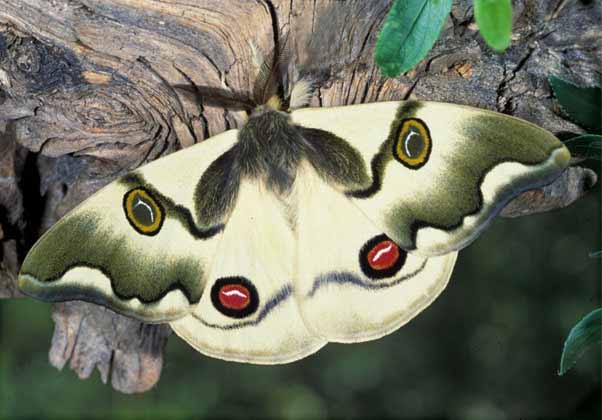use their
highly developed antennae to track the scent plume during the day to
locate the calling females.
EGGS, CATERPILLARS, COCOONS AND PUPAE:
Mature larvae spin a simple, pear-shaped, open mesh cocoon and
have the urticating spines typical of the
Hemileucinae.

Polythysana apollina larva courtesy of Kirby Wolfe.
Larval Food Plants
Listed below are primary food plant(s) and alternate food plants
listed in Stephen E. Stone's Foodplants of World Saturniidae
and/or on various internet sites. It is hoped that this alphabetical
listing followed by the common name of the foodplant will prove useful.
The list is not exhaustive. Experimenting with closely
related foodplants is worthwhile.
Aristotelia chilensis
Crinodendron patagua.......
Cryptocarya rubra......
Cryptocarya peumus
Kageneckia oblonga
Liquidambar
Maytenus boaria
Persea americana
|
Maqui
Lily Of The Valley Tree
Red laurel
Cryptocarya Peumus
Kageneckia oblonga
Sweetgum
Mayten
Avocado
|
Use your browser "Back" button to return to the previous page.
Return to Polythysana Genus
Return to South American Saturniidae Direcotry
Return to Main WLSS Index
The pronunciation of scientific names is
troublesome for many. The "suggestion" at the top of the page is
merely a suggestion. It is based on commonly
accepted English pronunciation of Greek names and/or some
fairly well accepted "rules" for latinized scientific names.
The suggested pronunciations, on this page and on other pages,
are primarily put forward to assist those who hear with internal
ears as they read.
There are many collectors from different countries whose
intonations and accents would be different.
Some of the early describers/namers chose genus
and species names indicating some character of the insect, but more
often, they simply chose names from Greek or Roman mythology or
history.Those species names which end in "ensis" indicate a
specimen locale, and those which end in "i", pronounced "eye", honour
a contempory friend/collector/etc.
I do not know the source of the genus
name "Polythysana" chosen by Walker in 1855.
The species name "apollina" probably comes from the Greek, where
Apolline is a girl's name, meaning sunshine. This may refer to the
male's daytime flight (9:00 am - 2:00pm) or to the bright slightly
yellowish-white ground colour.
This page is designed and maintained by Bill Oehlke as
part of the World's Largest Saturniidae Site.


